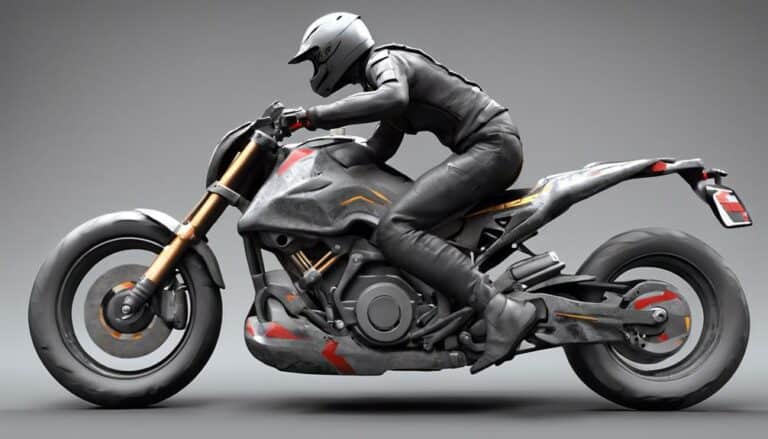When it comes to off-road motorcycle braking, did you know that body positioning can make a significant difference in your riding experience? By adjusting your body stance, you can enhance your braking efficiency and overall control of the bike.
But how exactly does body positioning affect your braking performance on challenging terrains? Let's explore the pivotal role that body positioning plays in optimizing your off-road motorcycle braking techniques.
Key Takeaways
- Proper body positioning enhances stability, control, and braking modulation off-road.
- Weight distribution impacts traction, stability, and obstacle navigation during braking maneuvers.
- Lower body movement improves traction, stability, and braking efficiency on challenging terrains.
- Upper body control influences stability, front wheel traction, and impact bracing while braking off-road.
Importance of Proper Body Positioning
Proper body positioning in off-road motorcycle braking is paramount for maintaining stability, control, and outstanding braking performance. As a rider, your body weight plays an important role in the distribution of weight between the front and rear wheel during braking. By leaning slightly forward and shifting your weight towards the front of the motorcycle, you enhance the grip on the front wheel, aiding in stability and control. This forward-leaning posture optimizes weight distribution, ensuring that the rear wheel maintains adequate traction for effective braking.
When you position your body correctly, you can apply the necessary pressure on the brakes to modulate braking force accurately. This skill allows you to prevent skidding on uneven terrains and maintain control over your off-road motorcycle. Additionally, the balanced weight distribution facilitated by proper body positioning reduces the chances of losing control and enhances overall braking performance. Remember, your body posture directly impacts traction and the efficiency of your braking maneuvers.
Impact of Body Weight Distribution
With a strategic distribution of your body weight during off-road motorcycle braking, you can greatly impact your control and stability on challenging terrains. Essential weight distribution plays a vital role in maintaining traction, preventing front-wheel skidding, and ensuring overall stability.
Here's how you can achieve this:
- Maximize Traction: Shift your weight towards the back of the motorcycle to increase traction with the rear wheel, especially on loose surfaces.
- Prevent Nosediving: Leaning slightly back while applying brakes helps prevent the bike from nosediving, keeping it balanced and stable.
- Navigate Obstacles: By adjusting your body position to shift weight rearward during braking, you can effectively control the bike and navigate obstacles with greater ease.
Role of Lower Body Movement
Engage your lower body muscles to facilitate best weight transfer and enhance braking control on off-road motorcycles. When you apply the brakes, your lower body movement is key to shifting weight towards the front wheel, improving traction, and enhancing stability. By actively engaging your lower body muscles, you can maintain balance and prevent skidding, especially on challenging off-road terrains. Leaning back slightly and utilizing your lower body strength allows you to effectively modulate braking power, giving you better control over your bike's movements. This enhanced control not only boosts braking efficiency but also increases your overall stability while riding in demanding off-road conditions.
| Lower Body Movement | Benefits |
|---|---|
| Shifts weight to front wheel | Improves traction |
| Enhances stability | Prevents skidding |
| Aids in balancing | Modulates braking power |
| Increases braking efficiency | Boosts control |
| Essential in off-road conditions | Enhances body positioning |
Influence of Upper Body Control
To optimize weight transfer and stability during off-road motorcycle braking, mastering upper body control is essential for riders. Proper upper body control plays a pivotal role in enhancing the effectiveness of off-road braking techniques. Here's how you can influence your riding experience through proper upper body control:
- Maintain an Upright Posture: By keeping your upper body upright, you can help distribute weight more evenly, improving stability and control during braking on uneven terrain.
- Enhance Front Wheel Traction: Leaning slightly forward with your upper body can increase the pressure on the front wheel, maximizing traction and allowing for more effective braking.
- Brace for Impact: Using your arms and upper body to brace for impact not only enhances control and stability but also enables you to absorb bumps and obstacles more effectively, contributing to a smoother off-road braking experience.
Mastering proper upper body control is essential for achieving the most stability and control while braking off-road, ensuring a safer and more controlled riding experience.
Significance of Head and Eye Placement
Proper alignment of your head and eyes is paramount for optimizing visibility and precision in off-road motorcycle braking maneuvers. When you maintain proper head placement, you enhance your visibility of the braking path and potential obstacles that lie ahead on the terrain. By keeping your head up and scanning the terrain ahead, you can identify braking zones and anticipate changes in the terrain early on.
Correct eye placement is essential for focusing on the braking point, enabling you to maintain precise control during off-road braking. Looking far ahead while braking not only aids in planning your braking technique but also helps in adjusting your body position and weight distribution for best control.
Coordinating your head and eye placement is important for effective off-road braking, as they play a significant role in guiding your body movements and ensuring proper weight distribution for successful maneuvers.
Conclusion
As you master the art of body positioning in off-road motorcycle braking, you enhance your control, stability, and safety on challenging terrains.
By adjusting your weight distribution, utilizing lower body movement, maintaining upper body control, and focusing on head and eye placement, you optimize braking power and prevent accidents.
Coincidentally, your increased confidence and skill in body positioning will elevate your overall off-road riding experience, making every adventure more exhilarating and rewarding.

